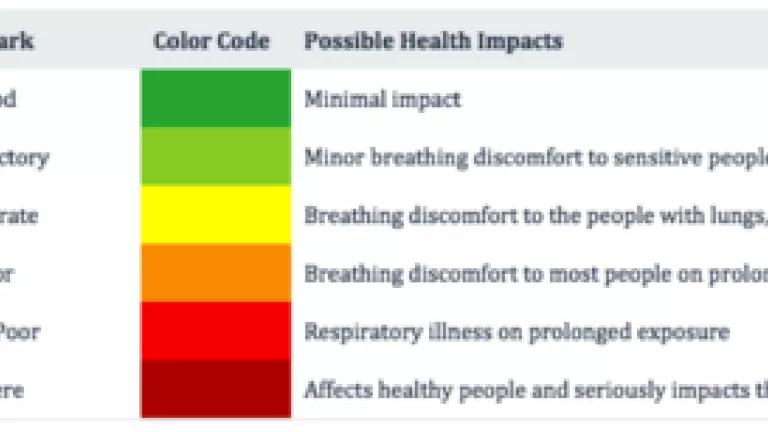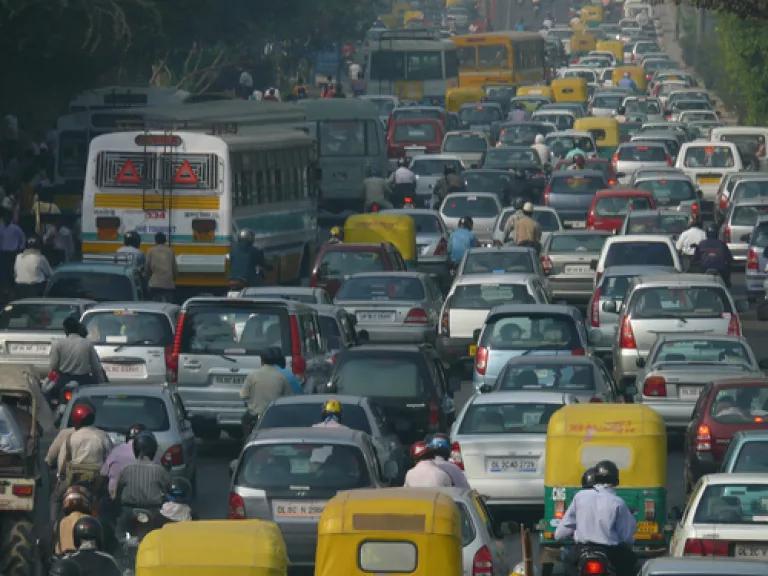
Co-authored by Amee Raval, NRDC India Climate Intern, and Ariel Cooper, NRDC India Initiative Program Assistant
To protect citizens from air pollution, the Indian government recently launched a National Air Quality Index (AQI) alert system that notifies the public about air pollution levels and associated health risks. On the heels of the new AQI, the Public Health Foundation of India (PHFI) and the Natural Resources Defense Council (NRDC) led a roundtable in New Delhi with leading experts to discuss the public health risks of air pollution and the need for increased health risk communication. With scientific collaboration and government attention, India is well poised to take concrete steps towards improving air quality.
Recent reports and growing public awareness are highlighting the increased threat of poor air quality on human health in India. The World Health Organization ranked 13 Indian cities among the top 20 in the world for the worst fine particulate air pollution. The Central Pollution Control Board (CPCB) found that in 2010, particulate matter in the air of 180 Indian cities was six times higher than World Health Organization standards. Poor air quality is proven to harm public health, from immediate infections to longer-term illnesses such as asthma and respiratory illness that can be deadly.
Highlights of India's New Air Quality Index
The AQI currently monitors air quality in ten cities - Delhi, Agra, Kanpur, Lucknow, Varanasi, Faridabad, Ahmedabad, Chennai, Bangalore, and Hyderabad. Five key pollutant levels are reported: PM10, PM2.5, SO2, NO2, and O3. The information from the monitoring stations is then displayed publicly to give real-time data on 24-hour particulate levels and potential health impacts.
Air Quality Index Breakpoints and Definitions
Like other AQI systems in Los Angeles, Mexico City, Beijing, Paris, and elsewhere, the AQI uses a color-coded advisory system that links each AQI category range with an air quality remark (e.g., severe, poor, or moderate) as well as possible health impacts like breathing discomfort and respiratory illness. This information is publicly available on the National Air Quality Index webpage with a map of monitoring station locations, real-time pollutant levels, overall AQI, and prominent pollutants of concern.
The AQI was developed by the Ministry of Environment, Forests, and Climate Change (MOEF-CC) and the CPCB along with researchers from the Indian Institute of Technology-Kanpur (IIT-Kanpur). Researchers at the Indian Institute of Tropical Meteorology in Pune with the Ministry of Earth Sciences are also collaborators with System of Air-quality Forecasting And Research (SAFAR).
To increase public communication, the new SAFAR-AIR mobile app provides AQI information on certain smart phones. The mobile app providing online air quality information in real time to select cities is currently in a pilot phase. To expand activities, the Indian government plans to install approximately six continuous monitoring stations and display boards in each city. The government also aims to expand monitoring stations in all Indian cities with a population larger than one million.
The AQI is an important first step to improving air quality in urban areas because it will improve public awareness on local pollution levels and associated health advisories. For example, the AQI identifies sensitive populations that should take special precaution including people with asthma, lung ailments, and heart disease. It also alerts people to make daily lifestyle adjustments on high severity days. This knowledge is also a critical precursor for government regulations and citywide mitigation activities. Experts suggest that expanded monitoring and the defined AQI will support enforcement of clean air standards that reduce public health risks.

Traffic congestion in Delhi. Photo by Deepak-commonwiki under Creative Commons licensing.
PHFI and NRDC Host Informal Roundtable on Health Risk Communication
PHFI and NRDC in collaboration with the Indo-US Science and Technology Forum (IUSSTF) led a roundtable discussion in mid-April focused on improving air quality risk communication following the release of the AQI. The Delhi discussion brought together Indian and US air quality and health scientists, researchers, and experts and facilitated scientific exchange on the state of air quality in India, the latest science on health impacts of air quality, and appropriate interventions to address health risks.
Dr. Dileep M. Chate, Deputy Chief Program Scientist from the Ministry of Earth Sciences and SAFAR attended as a special guest. Dr. Chate explained the new AQI and that SAFAR has an established, publicly available monitoring system and collects robust real-time data at 15 stations in India. Dr. Chate discussed how SAFAR both monitors current pollutant levels and uses a 72-hour forecasting system to facilitate early warning. He also highlighted SAFAR's new smartphone mobile application, a novel communication platform that has increased user accessibility of air quality data.
The session included discussions around public perceptions of air pollution, air quality monitoring and the recently released AQI, as well as customized health messaging strategies. Collaborative engagement between PHFI, NRDC, and SAFAR opened opportunities to link air quality scientific indicators with health-based public outreach. Examples were drawn from polio and tobacco control campaigns in India and the pollution control campaigns in Los Angeles, China and Mexico City. Participants also recommended sensitizing key stakeholders like health professionals and media groups to convey health risks and protective strategies to the public. They also noted that outreach can be targeted to vulnerable groups through simple, regionally specific, and empowering messaging tactics.
By engaging experts, the roundtable discussion initiated a conversation on scientific and policy collaboration on air quality risk communication. In developing our strategy, the group is looking forward to continued research collaborations that protect human health from harmful air pollution.
